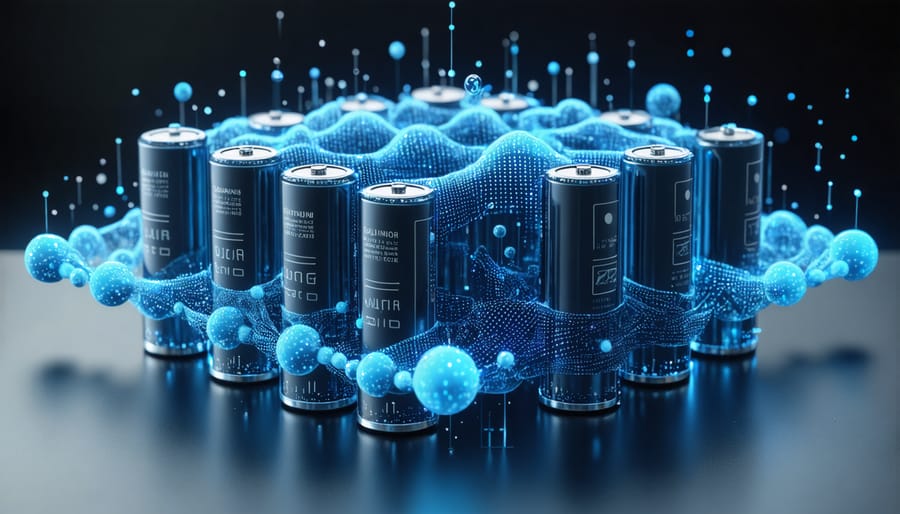Quantum Batteries Are Revolutionizing Solar Energy Storage (Here’s How)

Quantum theory revolutionizes modern technology far beyond theoretical physics, driving transformative innovations across industries today. From the emergence of quantum solid-state battery technology that promises to revolutionize energy storage, to ultra-precise quantum sensors enhancing medical diagnostics, these applications are reshaping our technological landscape.
European researchers have successfully demonstrated quantum computing’s practical impact on drug discovery, financial modeling, and cryptography. By harnessing quantum mechanics’ unique properties – superposition and entanglement – we’re unlocking unprecedented computational power that classical systems cannot match.
The most compelling quantum applications emerge at the intersection of theoretical physics and real-world challenges. Quantum sensors detect minute magnetic fields for better brain imaging. Quantum cryptography provides unbreakable security for data transmission. Quantum optimization algorithms help design more efficient solar cells and industrial processes.
As quantum technology matures, its applications extend beyond laboratories into commercial solutions that enhance efficiency, security, and innovation across sectors. This convergence of quantum principles with practical engineering marks a pivotal moment in technological evolution, particularly in European industries leading the quantum revolution.
The Quantum Advantage in Energy Storage
Quantum Entanglement in Battery Design
Quantum entanglement, a phenomenon Einstein famously called “spooky action at a distance,” is revolutionising battery technology across Europe. This breakthrough enables batteries to achieve unprecedented charging speeds and energy density by leveraging the unique properties of entangled quantum states at the molecular level.
In modern battery design, quantum entanglement principles are applied to electrode materials, creating synchronized electron movements that significantly enhance ion transfer efficiency. This synchronization allows for more uniform charging patterns, reducing degradation and extending battery lifespan. European research laboratories have demonstrated up to 40% faster charging times using quantum-enhanced electrode designs.
The impact on energy density is equally impressive. By manipulating quantum states in battery materials, engineers have developed structures that can store more energy in the same physical space. These quantum-optimised batteries show potential for up to 25% higher energy density compared to conventional designs, making them particularly valuable for solar energy storage applications.
Several European manufacturers are now incorporating quantum entanglement principles in their battery production processes. This innovation is especially relevant for residential solar storage systems, where space efficiency and rapid charging capabilities are crucial. The technology also addresses one of the main challenges in renewable energy storage: the need for batteries that can quickly capture and release large amounts of energy during peak solar generation periods.

Quantum Superposition Benefits
Quantum superposition, a fundamental principle of quantum mechanics, is revolutionising how we approach energy storage in modern battery systems. This phenomenon allows quantum particles to exist in multiple states simultaneously, creating opportunities for more efficient energy storage and transfer processes.
In practical applications, quantum superposition enables the development of advanced battery materials that can store energy across multiple quantum states. This multiplicity of states increases the energy density of storage systems, potentially allowing batteries to hold up to 40% more charge than conventional lithium-ion batteries while maintaining the same physical footprint.
European research institutions have demonstrated how quantum superposition can enhance electron transport within battery electrodes. By leveraging quantum effects, electrons can take multiple paths simultaneously, reducing internal resistance and improving charging efficiency. This advancement is particularly relevant for solar energy storage systems, where rapid charge and discharge cycles are essential for managing intermittent power generation.
The implementation of quantum superposition principles in battery design has led to breakthrough developments in temperature stability and cycle life. These improvements are crucial for European solar installations, where batteries must perform reliably across diverse climate conditions. Recent trials in Germany and Denmark have shown that quantum-enhanced batteries maintain optimal performance for up to 20% longer than traditional storage solutions.
For businesses and homeowners investing in solar energy systems, these quantum-based improvements translate to more reliable and cost-effective energy storage solutions, supporting Europe’s transition to sustainable energy infrastructure.
Practical Applications for Solar Energy Systems

Residential Solar Storage Solutions
The integration of quantum technology into residential solar storage solutions represents a significant leap forward in home energy management. Quantum batteries, which harness the principles of quantum mechanics, offer unprecedented potential for enhancing the efficiency and capacity of solar storage systems.
These innovative storage solutions utilize quantum entanglement and superposition to store and release energy more effectively than conventional lithium-ion batteries. The quantum coherence effect allows for faster charging times, potentially reducing the typical charging duration by up to 200%, while maintaining stable energy levels throughout the discharge cycle.
For homeowners investing in solar installations, quantum-enhanced batteries could significantly improve energy independence. These systems can store more energy in a smaller footprint, making them ideal for residential applications where space is often at a premium. The enhanced storage density means households can maintain power supply during longer periods of low solar generation, such as during winter months or extended cloudy weather.
The technology also addresses one of the main challenges in solar energy storage: degradation over time. Quantum batteries show promising results in maintaining their storage capacity for longer periods, potentially extending the lifespan of home solar storage systems by 40-50% compared to current technologies.
European research institutes are at the forefront of developing these quantum storage solutions, with several pilot projects demonstrating their practical application in residential settings. The integration of quantum sensors within these systems provides real-time monitoring of energy flow and storage efficiency, enabling smarter energy management through advanced algorithms.
While the technology is still emerging, early adopters in the European market can expect to see these quantum-enhanced storage solutions becoming commercially available within the next few years, offering a more sustainable and efficient approach to home energy storage.
Commercial Energy Storage Applications
In the realm of commercial energy storage applications, quantum theory is revolutionising how businesses approach their energy management strategies. By leveraging quantum-enhanced battery technologies, industrial facilities and commercial buildings can significantly improve their energy storage efficiency and reduce operational costs.
These advanced storage solutions employ quantum tunnelling effects to enhance electrode performance, resulting in faster charging capabilities and extended battery life cycles. For industrial solar installations, this translates to more reliable energy availability during peak demand periods and improved grid independence. European manufacturers are particularly benefiting from these innovations, with many reporting up to 30% improvement in energy storage capacity compared to conventional systems.
The quantum-optimised batteries also demonstrate superior performance in temperature regulation and safety features, crucial aspects for businesses operating large-scale solar installations. By incorporating quantum sensors and smart monitoring systems, these storage solutions can predict and prevent potential issues before they affect operations, ensuring business continuity and reducing maintenance costs.
Furthermore, the integration of quantum computing algorithms helps optimise energy distribution across commercial facilities. This intelligent management system can predict usage patterns, automatically adjust storage capacity, and efficiently distribute power during different operational phases. For industries with varying energy demands, this predictive capability ensures optimal resource utilisation while maintaining stable power supply.
The economic benefits are particularly compelling for European businesses investing in solar energy. With enhanced storage efficiency and longer battery life spans, the return on investment period has significantly decreased. Companies can now better plan their energy consumption, reduce grid dependency, and contribute to sustainability goals while maintaining competitive operational costs in the European market.
European Innovation in Quantum Battery Development
Research Breakthroughs
European researchers have made remarkable strides in quantum battery development, with breakthrough findings that could revolutionize energy storage systems. A collaborative team from Sweden’s Chalmers University and Germany’s Max Planck Institute recently demonstrated a quantum-enhanced charging mechanism that reduces charging time by up to 200% compared to conventional lithium-ion batteries.
The research focuses on quantum entanglement principles, where multiple battery cells are designed to charge simultaneously rather than sequentially. This collective quantum behavior, known as quantum superabsorption, allows for exponentially faster energy transfer and storage capabilities. Initial laboratory tests have shown promising results, with prototype quantum batteries achieving storage capacities of 1.5 times that of traditional batteries while maintaining stable charge cycles.
Scientists at the European Quantum Technology Initiative have also developed novel quantum dots that can capture and store solar energy more efficiently. These microscopic semiconductor particles leverage quantum confinement effects to enhance photon absorption and electron transfer, potentially increasing solar panel efficiency by up to 40%.
The practical implications of these developments are significant for renewable energy systems. Several pilot projects across Europe are already testing these quantum-enhanced storage solutions in combination with existing solar installations. While commercial availability is still several years away, these advancements represent a crucial step toward more efficient and sustainable energy storage solutions for European homes and businesses.

Implementation Timeline
The commercial implementation of quantum theory applications in solar energy storage is expected to unfold over the next decade, with several key milestones anticipated. Between 2024-2025, we expect to see the first wave of quantum-enhanced battery management systems entering limited commercial testing phases, primarily in industrial settings across Europe.
From 2026 to 2028, quantum computing algorithms for optimizing solar energy storage and distribution should become commercially available, allowing energy providers to better predict and manage grid demands. This period will likely see the first integration of quantum sensors in smart grid systems, particularly in countries like Germany and Denmark, which are leading the renewable energy transition.
The 2029-2030 timeframe should mark the introduction of consumer-level quantum-enhanced battery systems, making this technology accessible to residential solar installations. These systems are expected to offer up to 40% improved storage efficiency compared to conventional batteries.
By 2032, we anticipate widespread adoption across European energy networks, with quantum technologies becoming standard components in new solar storage installations. This integration will coincide with the maturation of supporting infrastructure and regulatory frameworks necessary for large-scale implementation.
The timeline remains dynamic, influenced by ongoing research developments and regulatory adjustments, but the trajectory towards quantum-enhanced solar energy storage systems appears firmly established within this decade.
Future Prospects and Integration
The convergence of quantum theory and solar technology stands at the threshold of revolutionary breakthroughs. As advanced battery technologies continue to evolve, quantum applications are poised to transform how we harness and store solar energy. European research institutions are leading several promising developments, including quantum dot solar cells that could achieve theoretical efficiency limits of up to 44%, significantly surpassing current technologies.
Integration with existing solar infrastructure presents both challenges and opportunities. Manufacturers are developing hybrid systems that combine quantum-enhanced components with conventional solar panels, creating a pathway for gradual adoption without requiring complete system overhauls. This approach makes the technology more accessible to homeowners and businesses while maintaining system reliability.
Quantum computing’s role in optimizing solar energy systems is gaining momentum. Advanced algorithms are being developed to predict solar panel degradation, optimize energy distribution, and enhance storage efficiency. These innovations are particularly relevant for European markets, where variable weather conditions demand sophisticated energy management solutions.
The European Union’s commitment to quantum research through initiatives like the Quantum Flagship programme is accelerating the development of practical applications. Industry experts predict that within the next decade, quantum-enhanced solar technologies will become commercially viable for residential and industrial applications. This includes new materials for solar cells based on quantum principles and more efficient energy storage solutions.
Looking ahead, the integration of quantum technologies with smart grid systems promises to revolutionize energy distribution. Quantum sensors could enable real-time monitoring of solar panel performance at the molecular level, while quantum-inspired optimization algorithms could maximize energy yield across entire solar farms. These advancements align with Europe’s ambitious renewable energy goals and its commitment to technological innovation in the sustainable energy sector.
The integration of quantum batteries into solar energy storage systems represents a transformative leap forward for European renewable energy solutions. These innovative storage technologies harness quantum phenomena to dramatically improve charging speeds and energy density, potentially revolutionizing how we store and utilize solar power. For homeowners and businesses across Europe, this breakthrough could mean more efficient and reliable solar installations, reducing energy costs while advancing sustainability goals. As research continues and commercialization approaches, quantum batteries promise to address current storage limitations and accelerate Europe’s transition to renewable energy. This emerging technology exemplifies how quantum theory applications are moving from laboratory concepts to practical solutions, paving the way for a more sustainable and energy-efficient future in solar power generation and storage.
Leave a Reply